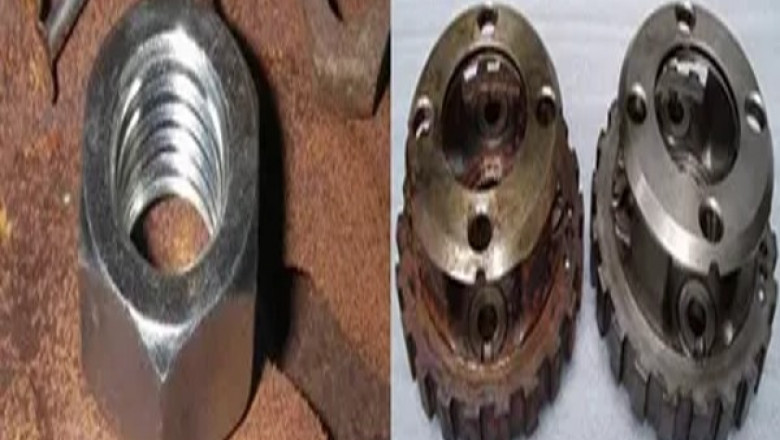views
The Causes and Effects of Rust
Rust is an oxidation process that affects iron and iron-based alloys like steel. It occurs when iron is exposed to oxygen and moisture in the air. The oxygen molecules interact with the iron atoms, breaking down the protective layer and forming rust. Repeated exposure over time causes further deterioration. Some key factors that promote rust formation are proximity to saltwater or other corrosive environments, fluctuations in temperature and humidity, lack of a protective coating, scratches or abrasions in any existing paint or other barrier. Left untreated, rust can eat away at metal surfaces and weaken the structural integrity of materials.
Different Types of Rust Removal Methods
There are a few different categories of Rust Remover methods that can be used depending on the severity of corrosion and the desired finished appearance. Mechanical removal techniques use abrasion to scrape or sand rust away. Chemical treatments break down rust chemically. Electrolytic techniques use electricity to speed up chemical reactions. Each has pros and cons for different applications.
Mechanical Removal
The simplest method is mechanical removal by scraping, wire brushing or sanding rust off a surface. This works well for light to moderate surface rust but is time-consuming for heavy corrosion. It runs the risk of damaging the underlying metal if abrasion is too severe. Mechanical tools are inexpensive and don't require protective equipment, making them good for do-it-yourself jobs. However, they may not fully remove all rust at the substrate level.
Chemical Treatments
Commercial chemical rust removers use acids or other strong solutions to break down rust at a chemical level. Phosphoric acid-based gels or pastes are common for metal substrates that can be submerged, while others work as spray-on solutions. These treatments are more effective than mechanical options for heavy corrosion. Downsides include handling hazardous chemicals, potential damage if solutions are not fully neutralized and rinsed away, and hazardous waste disposal. Protection like gloves and goggles is essential.
Electrolytic Rust Removal
This process uses an electrical current to accelerate a controlled chemical reaction and dissolve rust rapidly. The piece is submerged as the anode in a water-based solution, sometimes containing minor acids, while a second cathode piece receives electricity. Current flow enables ion exchange that removes rust layers without harming base metal. It works well even for embedded rust but requires electrical equipment setup. Overall time commitment tends to be lower than other methods.
Choosing the Best Removal Method
Analyzing the level and location of rust is important for determining the most suitable treatment. Light surface rust can often be addressed mechanically. Moderate corrosion may respond to chemical gels or electrolysis depending on part accessibility. Completely rusted parts may necessitate complete media blasting or immersion stripping. The finish required after rust removal also influences decisions between a mechanical "as-cleaned" look versus full metal brightening. In some restoration projects, a combination of methods provides the best results.
Protecting Against Future Rust
No rust removal is complete without steps to inhibit new corrosion. Thoroughly cleaning and drying the surface prepares it for a protective coating. For interior metals, applying a suitable rust preventative like oil or grease forms a barrier. On exterior surfaces, painting or other durable finishes are typical options. Epoxy paints perform well in many environments. Galvanizing through hot-dip or electroplating provides a sacrificial zinc layer that actively prevents rusting. With proper selection and reapplication intervals tailored to exposure conditions, these sealants can guard metal treatments for years of service.
Case Study: Restoring a Rusted Automotive Frame
A vintage truck owner wanted to refurbish a badly corroded frame for a long-term restoration project. The extensive rust had corroded through in spots and weakened structural integrity. After assessing removal options, it was determined electrolysis was the best method. A large tank was filled with an inhibited rust remover solution. The disconnected frame was fully immersed as the anode while plates served as cathodes. Over several days, this actively dissolved all rust layers down to bare metal.
Any areas needing further cleaning were mechanically wire brushed. The fully exposed substrate was then sealed with a corrosion inhibitor to protect raw surfaces through the next stages. Sections requiring patching had new steel welded in place. Finally, an epoxy primer and topcoat system were applied to the entire protected frame. Several years later after reassembly, undercoat reapplication has kept the refurbished chassis rust-free for continued enjoyment. Proper rust removal and protection allowed preserving this vintage machine for the future.
For Deeper Insights, Find the Report in the Language that You want.
About Author:
Vaagisha brings over three years of expertise as a content editor in the market research domain. Originally a creative writer, she discovered her passion for editing, combining her flair for writing with a meticulous eye for detail. Her ability to craft and refine compelling content makes her an invaluable asset in delivering polished and engaging write-ups.
(LinkedIn: https://www.linkedin.com/in/vaagisha-singh-8080b91)






















Comments
0 comment